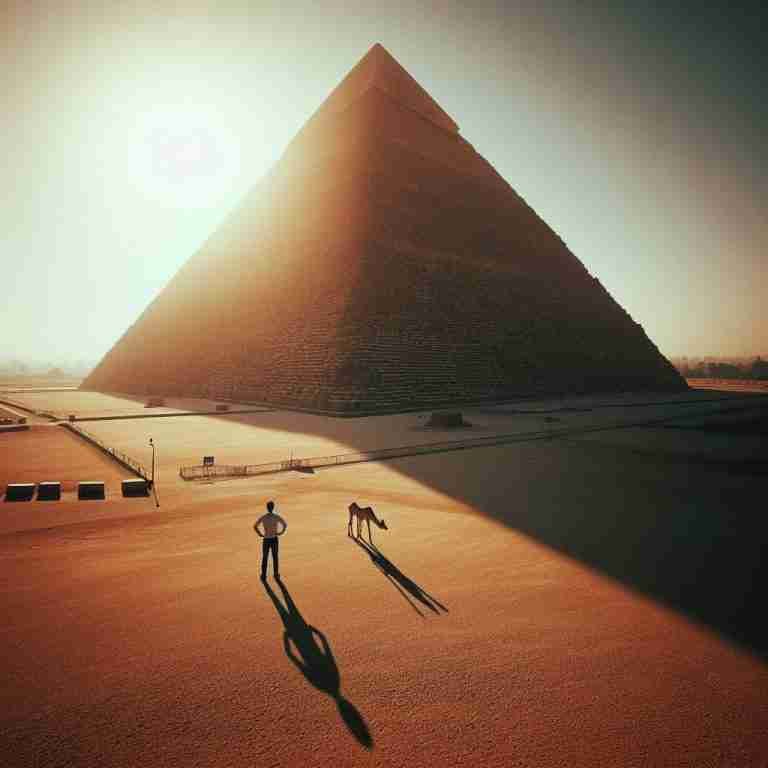The Great Pyramid of Giza: A Monumental Comparison
The Great Pyramid of Giza, one of the most iconic pyramids in the world, is a true marvel of human achievement. Its massive size, standing at 455 feet (138.8 meters) tall, and covering a base of over 13 acres, is a testament to the ingenuity and skill of ancient builders. As I explore its construction and historical significance, I can’t help but marvel at how it compares to the size and achievements of humanity.
Comparing the Height of the Great Pyramid to the Average Human
Discover the mind-blowing differences in height between the Great Pyramid of Giza and the average human, and gain a new perspective on just how massive this ancient wonder truly is.
Great Pyramid of Giza Size
The Great Pyramid of Giza is an architectural marvel, with dimensions that are truly awe-inspiring. Here are the key details about its size:
- The pyramid stands at a height of 455 feet (138.8 meters), making it one of the tallest man-made structures in the world.
- Its base covers an area of 13 acres (5.3 hectares), with each side measuring approximately 756 feet (230.4 meters).
- The volume of the pyramid is estimated to be around 2.6 million cubic meters, showcasing the immense scale of this ancient wonder.
When compared to the size of a human, the Great Pyramid of Giza is truly monumental. Its height alone dwarfs the tallest skyscrapers, and its base could easily accommodate several football fields. The sheer volume of the pyramid is a testament to the incredible feat of engineering and construction achieved by the ancient Egyptians, especially when considering the tools and technology available to them at the time.
These dimensions not only highlight the grandeur of the pyramid, but also serve as a reminder of the remarkable capabilities of human ingenuity and craftsmanship.
Construction and Architecture
The construction of the Great Pyramid of Giza is a remarkable feat of engineering and architecture. The ancient Egyptians used sophisticated techniques and materials to build this monumental structure, which continues to astound researchers and visitors alike.
The construction techniques and materials used in building the Great Pyramid of Giza include:
- Enormous limestone blocks, some weighing as much as 80 tons, were quarried and transported to the construction site.
- Workers used ramps and levers to move and position the massive stones, demonstrating incredible organizational and engineering skills.
- The precision with which the stones were cut and placed is a testament to the advanced knowledge and craftsmanship of the ancient Egyptians.
When comparing the construction of the Great Pyramid of Giza to human capabilities, it becomes evident that the sheer scale and precision of the pyramid’s construction surpasses what would seem possible for the time period. The pyramid’s construction challenges our understanding of ancient engineering and raises questions about the methods and tools used by the ancient Egyptians.
 Historical and Cultural Significance
Historical and Cultural Significance
The Great Pyramid of Giza holds immense historical and cultural significance, making it a marvel of human achievement and a symbol of ancient Egyptian culture.
Historical Importance
The construction of the Great Pyramid of Giza dates back to around 2580-2560 BC, during the Fourth Dynasty of the Old Kingdom of Egypt. It served as a monumental tomb for the Pharaoh Khufu, also known as Cheops, and was part of a larger complex that included temples, smaller pyramids, and tombs for members of the royal family and officials. The pyramid’s construction reflects the advanced engineering and architectural knowledge of the ancient Egyptians, showcasing their ability to plan and execute such a massive project with precision and skill.
Cultural Impact
The Great Pyramid of Giza has become a symbol of ancient Egyptian culture and civilization, representing the power and grandeur of the pharaohs and their divine connection to the afterlife. Its colossal size and precise alignment with the cardinal points have captured the imagination of people for centuries, inspiring countless theories and speculations about its purpose and construction. The pyramid’s enduring legacy continues to fascinate and intrigue people from around the world, drawing millions of visitors each year to witness this extraordinary feat of human ingenuity.
The comparison of the Great Pyramid of Giza to human achievements highlights the remarkable capabilities of ancient civilizations and their ability to create enduring monuments that stand the test of time. Its historical and cultural significance serves as a testament to the ingenuity and creativity of humanity throughout the ages.
Comparison to Other Pyramids
When comparing the Great Pyramid of Giza to other famous pyramids around the world, several unique features and size differences become apparent. Here are some key points to consider:
Great Pyramid of Giza vs. Pyramid of the Sun (Mexico)
- The Great Pyramid of Giza is significantly taller, standing at 455 feet (138.8 meters) compared to the Pyramid of the Sun’s 233 feet (71 meters).
- However, the base of the Pyramid of the Sun is larger, measuring 733 feet (224 meters) on each side, while the base of the Great Pyramid of Giza is 756 feet (230.4 meters) on each side.
- Both pyramids showcase the impressive capabilities of ancient civilizations in constructing monumental structures that stand the test of time.
Great Pyramid of Giza vs. Pyramid of Khafre
- The Pyramid of Khafre is slightly smaller in height, standing at 448 feet (136.6 meters) compared to the Great Pyramid of Giza’s 455 feet (138.8 meters).
- However, the Pyramid of Khafre is built on a higher elevation, giving it the appearance of being taller when viewed from a distance.
- Both pyramids are part of the Giza pyramid complex and hold significant historical and cultural importance in ancient Egypt.
Great Pyramid of Giza vs. Pyramid of the Moon (Mexico)
- The Great Pyramid of Giza is considerably larger in volume, with an estimated volume of 2.6 million cubic meters, compared to the Pyramid of the Moon’s 1.2 million cubic meters.
- Both pyramids are aligned with celestial phenomena, showcasing the advanced astronomical knowledge of the civilizations that built them.
- The comparison highlights the diversity of pyramid construction and their cultural significance across different regions of the world.
Overall, the comparison of the Great Pyramid of Giza to other pyramids emphasizes the remarkable achievements of ancient civilizations in constructing monumental structures that continue to captivate and inspire people today.
Conclusion
Throughout this article, we have explored the Great Pyramid of Giza and its significance in history and culture. We have delved into its size, construction, historical and cultural importance, and compared it to other pyramids around the world. The Great Pyramid of Giza stands as a testament to human achievement and ingenuity, and its comparison to human size and capabilities is truly remarkable.
As we conclude, it is evident that the Great Pyramid of Giza is a marvel of ancient engineering and architecture. Its size and construction techniques are awe-inspiring, especially when compared to the capabilities of humans. The historical and cultural significance of the pyramid further emphasizes its importance in human history and culture.
Overall, the Great Pyramid of Giza continues to captivate and intrigue people from around the world. Its comparison to human size and achievements serves as a reminder of the incredible feats that humans are capable of achieving.


Comments are closed.